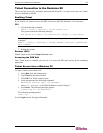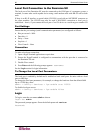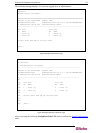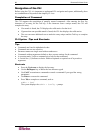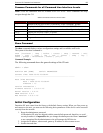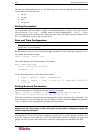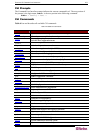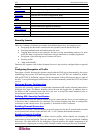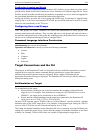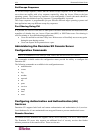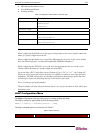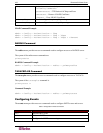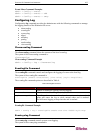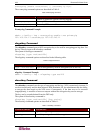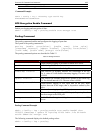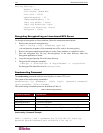
CHAPTER 12: COMMAND LINE INTERFACE 103
Configuring Logging and Alerts
As part of the security capabilities of the Dominion SX, facilities are provided to log data and to
provide alerts based on activities between the users, Dominion SX and the target device. These
facilities provide an audit trail allowing the authority responsible to review what has happened in
the system and determine who implemented what action and when.
Among the facilities provides are event logging and SNMP traps. Events may be logged locally
using Syslog. Local events are maintained in a 256K per port buffer and can be stored, reviewed,
cleared or sent periodically to an FTP server.
Configuring Users and Groups
Users and groups are related. Dominion SX allows the administrator to define groups with
common permissions and attributes. They can then add users to the groups and each user takes o
the attributes and permissions of that group. By enabling groups, the permissions for each user do
not have to be configured reducing the time to configure users.
Command Language Interface Permissions
Administrators can execute all commands.
Operators and Observers can only execute the following commands:
• Connect
• Help
• Listports
• Logout.
• Password
Target Connections and the CLI
The purpose of the Dominion SX unit is to let authorized users establish connections to various
targeted devices using the connect command. Before connecting to a target the terminal
emulation and escape sequence must be configured. When a target is disconnected, the
appropriate disconnect message is displayed. The Dominion SX unit also provides the ability to
share ports among users.
Set Emulation on Target
To set emulation on the target:
• Ensure that the encoding in use on the host matches the encoding configured for the
target device. For example, if the character-set setting on a SUN Solaris server is set to
ISO8859-1, the target device should also be set to ISO8859-1.
• Ensure that the terminal emulation on the target host connected to the Dominion SX
serial port is set to VT100, VT220, VT320 or ANSI.
On most UNIX systems, export TERM=vt100 (or vt220|vt320|ansi)” sets the preferred terminal
emulation type on the UNIX target device. For example, if the terminal type setting on a HP-UX
server is set to VT100, the Access Client should also be set to VT100.
The setting for terminal emulation on the Dominion SX unit is a property associated with the port
settings for a particular target device. Ensure that the settings for terminal emulation in the client
software, for example, Telnet or SSH client, are capable of supporting the target device.



